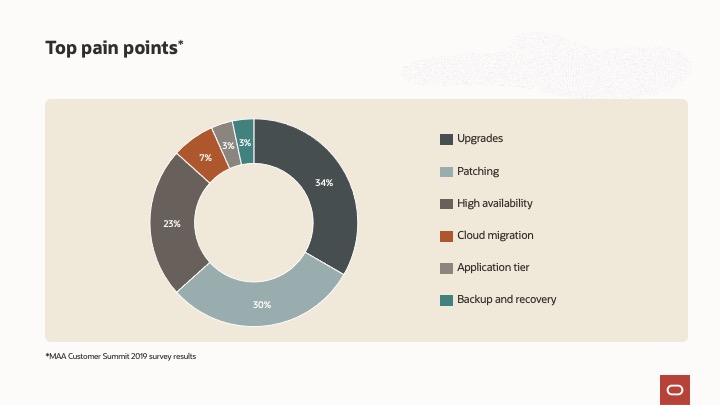Patching and upgrading databases and infrastructure can be a tedious experience. It could consume a lot of your time, particularly if you fail to invest in proper automation and standardization. The challenges and time commitment are compounded as your database fleet grows and diverges regarding database versions, patch levels, and configuration drift.
An Oracle survey conducted in 2019 at the Maximum Availability Architecture (MAA) Summit revealed that patching and upgrading are considered the top pain points for many Oracle Database customers.

Fleet Patching and Provisioning (FPP) helps to resolve these issues on-premises and can manage targets on the Oracle Cloud (see more later in this article) , It has many features to help you climb and overcome the patching and upgrading mountain while eliminating the headaches and challenges associated with manual, error-prone maintenance processes for the Oracle Database.
Fleet Patching & Provisioning, you say?
Over the years, more and more functionality was added to the Oracle Database product feature set framework associated with patching and upgrades. What started as a DB Home provisioning and Oracle Database upgrade framework quickly evolved due to customer demand for more automation and standardization that formed the core functionality.
Initially, the focus was on rapidly provisioning homes and hence was originally named Rapid Home Provisioning (RHP). However, as the functionality expanded, the name became insufficient to describe the full functionality of the framework. Thus, the product was renamed Fleet Patching & Provisioning (FPP).
The product had evolved into a tool capable of gold image-based patching and upgrading Oracle Grid Infrastructure and Database software homes, and more recently, Oracle Exadata Infrastructure. These days, it handles the installation of new servers with Oracle Grid Infrastructure, Oracle Database homes, and even empty databases for both Single Instance and Real Application Clusters (RAC) deployments on Exadata or generic hardware environments, across which it can even identify configuration drifts against the gold image standards utilized for patching and upgrades, providing ongoing standardization.
In addition to the extensive use of Fleet Patching and Provisioning (FPP) by major enterprise customers for patching and upgrading thousands of Databases and Grid Infrastructure on-premises, FPP is also used in the Oracle Cloud for Autonomous Database and Oracle Cloud Database Services.
For Autonomous Database, FPP has been used as the fleet patching solution for this service since its inception. It was part of the original design architecture and is deployed in production across all cloud regions. FPP has also been used for Autonomous Database Cloud@Customer.
On Exadata Cloud@Customer (ExaCC), FPP has been serving as the fleet patching solution for a major telecom company meeting the Oracle Database and Grid Infrastructure patching as well as upgrades requirements for their fleet consisting of hundreds of databases.
On Exadata Cloud Service (ExaCS), FPP has been implemented as part of the overall end-to-end automation by the Fusion Applications team for all their Oracle Database and Grid Infrastructure patching and upgrade needs, which include approximately 20,000 databases.
As many ask about licensing for FPP, the good news is that you are licensed to use this product if your targets have Oracle RAC or Oracle RAC One licenses or have licensed the Enterprise Manager Database Lifecycle Management (DBLM) Pack for single-instance databases.
Version 13.5.0.14 of Enterprise Manager (EM) makes it is possible to manage FPP servers via the EM console, if you want to use this feature you will have to license the DBLM pack also for Oracle RAC or Oracle RAC One node targets.
What’s next?
With such an abundance of lifecycle automation features, starting with FPP can be intimidating. It can be challenging to determine where to begin working this powerful solution into your overall system architecture. To simplify your experience, I am releasing a series of blog posts called FPP by Example over the coming months, which will help guide you to get started and up to speed with FPP and supercharge your Patching, Provisioning, and Upgrade experience.
We will cover the basics and more advanced topics such as Peering, User actions, and setting up FPP to be able to use the REST API. This blog post will continue to be updated to provide links to the subsequent blog articles as they are published:
Fleet Patching & Provisioning by Example Intro
Fleet Patching & Provisioning by Example Part 1 : Architecture – Concepts
Fleet Patching & Provisioning by Example Part 2 : FPP Server Installation
Fleet Patching & Provisioning by Example Part 3 : Creating Gold Images
